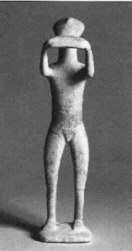
www.musikarchaeologie.de/

Syrinx Player Tunis, 4th Cent CE

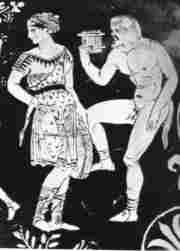
www.musikarchaeologie.de/
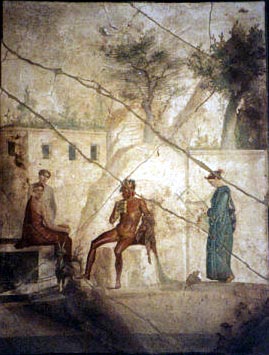


http://www.sikyon.com/Sicyon/Museum/museum_gr17.html
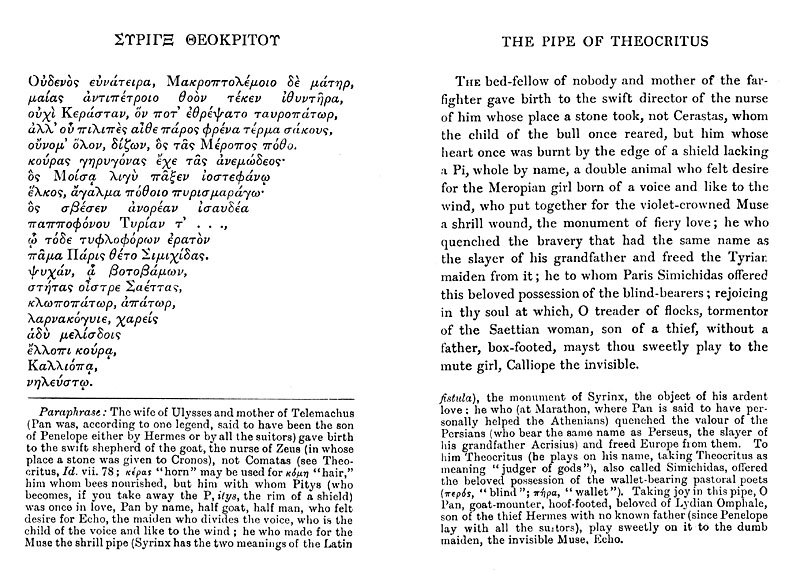
"H σύντροφος κανενός στο κρεβάτι και μητέρα εκείνου που πολεμά μακριά γέννησε τον γρήγορο κύριο της θεραπαινίδας εκείνου που τη θέση του πήρε μια πέτρα, όχι ο Κεραστάς(;) αλλά εκείνος που μία φορά κάηκε η καρδιά του από το χείλος μιας ασπίδας χωρίς Πι. Ολόκληρος στο όνομα, διπλό ζώο, που ερωτεύτηκε τη Μερόποια κοπέλα που γεννήθηκε από μία φωνή και σαν τον άνεμο, εκείνος που για χάρη της στεφανωμένης με βιολέτες Μούσας ένωσε μια σφυριχτή κραυγή, το μνημείο της φλογερής αγάπης του. Εκείνος που έσβησε την ανδρεία που είχε το ίδιο όνομα με το φονιά του παππού του και ελευθέρωσε την Τυρίαν από αυτήν. Εκείνος στον οποίον ο Πάρης Σιμιχίδας πρόσφερε το αγαπημένο απόκτημα των τυφλών. Αναγαλλιάζοντας με αυτό, εσύ που χτυπάς(;) τα κοπάδια (βοτοβαμων), βασανιστή των Σαέττιων γυναικών, γιε του κλέφτη, χωρίς πατέρα, με πόδια λάρνακας [(;)box-footed], πρέπει να παίζεις γλυκά στο άφωνο κορίτσι, την αόρατη Καλλιόπη."
In the 1950's I stumbled upon The Greek Anthology - Vol 5 - Loeb Classical Library - 1953 - Book XV - MISCELANEA EPIGRAM 21- The Pipe Of Theocritus- A picture of the pipe of Pan in words written about Pan.
http://www.thegatesofparadise.com
http://www.thegatesofparadise.com
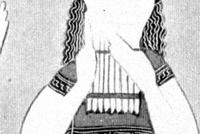 Florence 4209
Florence 4209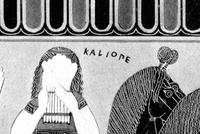
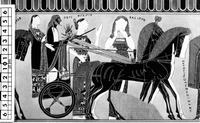 François Vase: Detailed drawing of the main frieze, chariot of Hera and Zeus, preceded by the Muses, Ourania and Kalliope; signature of Ergotimos (�Ergotimas made itΣ) in the lower right corner
François Vase: Detailed drawing of the main frieze, chariot of Hera and Zeus, preceded by the Muses, Ourania and Kalliope; signature of Ergotimos (�Ergotimas made itΣ) in the lower right cornerFrom FR, pls. 1-2, 1993
Copyright notice. About image tiling.
Vase Catalog Number: Florence 4209
Behind these deities come a series of chariots accompanied by walking figures. First of these is the chariot of Zeus and Hera. Their pole horses have topknots and hold their heads up high; the following horses hold their heads down. Zeus holds his thunderbolt, whip and reins, and wears a long white peplos and mantle. Hera, beside him, wears a figured peplos and mantle, and holds her mantle with her left hand. Their chariot is accompanied by the first group of nine Muses: here, Kalliope, full frontal and playing the Pan-pipes (syrinx), and Ourania, her hair tied in a bun, wearing a figured peplos and holding her left hand in the air.
Behind these deities come a series of chariots accompanied by walking figures. First of these is the chariot of Zeus and Hera. Their pole horses have topknots and hold their heads up high; the following horses hold their heads down. Zeus holds his thunderbolt, whip and reins, and wears a long white peplos and mantle. Hera, beside him, wears a figured peplos and mantle, and holds her mantle with her left hand. Their chariot is accompanied by the first group of nine Muses: here, Kalliope, full frontal and playing the Pan-pipes (syrinx), and Ourania, her hair tied in a bun, wearing a figured peplos and holding her left hand in the air.
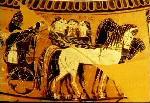 Sophilos (c. 580 BC-)
Sophilos (c. 580 BC-)Greek vase painter. The artist is known for his Black-figures. The style is based on the Corinthian approach with decorations often based on real or mythological animal motifs. Some 40-46 of his artifacts survive either as large pots or as fragments. Sophilos was the first Greek vase painter whose real name is known as he signed several of his works. [Adapted from Grove Dictionary of Art]
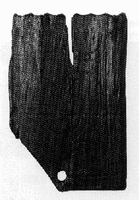 Picture left : Musée Alésia, Alise-Saint-Reine
Picture left : Musée Alésia, Alise-Saint-ReinePicture right: Rijksdienst voor Oudheidkundig Bodemonderzoek
By blowing on the upper side, the air is vibrated in the tubes. The height of the tones depends on the lenght of the tube: the shorter the tube, the heigher the tune. In the early days, the tubes had an equal length and to tune the pan-pipes, one used wax. One put wax in the tube until the tune was just right. It was also used to close scratches or little openings in the side. The inside was also rubbed with wax to get a smooth sound. Later, one made the tubes out of different lenghts (CF; picture pan-pipe from Alesia). The notes of the pipes go from the lowest tone right, the highest one left. Strange, if we compare this with the piano, this is turned around.
Marshall F. H. Catalogue of the finger rings, Greek, Etruscan and Roman in the Departments of Antiquities, British Museum. 1968
 ROMAN BRONZE PENDANT
ROMAN BRONZE PENDANT
I-II c. A.D.
Cast bronze figure of Harpokrates, wearing tall headdress, with his right hand raised to his lips. Suspension loop in vertical plane at his back. 1 5/8" (4cm).
 ROMAN BRONZE PENDANT
ROMAN BRONZE PENDANTI-II c. A.D.
Cast bronze figure of Harpokrates, wearing tall headdress, with his right hand raised to his lips. Suspension loop in vertical plane at his back. 1 5/8" (4cm).
 From Caskey & Beazley, plate XV. With permission of the Museum of Fine Arts, Boston.
From Caskey & Beazley, plate XV. With permission of the Museum of Fine Arts, Boston.Copyright notice.
Illustration of Boston 98.887
 From Caskey & Beazley, plate XV. With permission of the Museum of Fine Arts, Boston.
From Caskey & Beazley, plate XV. With permission of the Museum of Fine Arts, Boston..
 Delphi, Anonymous Caryatid: Anonymous Caryatid, frontal view
Delphi, Anonymous Caryatid: Anonymous Caryatid, frontal viewPhotograph by Maria Daniels, courtesy of the Greek Ministry of Culture and the Delphi Museum
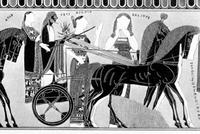 François Vase: Drawing of the main frieze (wedding of Peleus and Thetis), left half, showing a procession of deities
François Vase: Drawing of the main frieze (wedding of Peleus and Thetis), left half, showing a procession of deitiesFrom FR, pls. 1-2, 1993
Copyright notice. About image tiling.
Illustration of Florence 4209 (Browse more pictures of same)
 Main panel: Satyr and Pan
Main panel: Satyr and PanPhotograph courtesy of the Trustees of the British Museum,
Illustration of London E 228
 London 1971.11-1.1: Upper frieze: wedding of Peleus and Thetis: Aphrodite and Ares in chariot, Muses behind horses
London 1971.11-1.1: Upper frieze: wedding of Peleus and Thetis: Aphrodite and Ares in chariot, Muses behind horsesBritish Museum, London
http://www.soundcenter.it/cdflautieng.htm
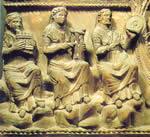 THE FLUTE OF PAN OR SYRINX
THE FLUTE OF PAN OR SYRINXAmong the flutes employed by the Etruscans, those excelling all others were syringe or syrinx, that is the flute of Pan, instruments that belong to the most ancient and mythical history of the music.
 Pensive Pan: Ancient God of Sacrificial Fertility. He was the goat-hooved and lusty king of the Arcadian forest, the original Horned One. His Neolithic cult was later subsumed in the ecstatic wine-rituals of Dionysian Greece. This seated representation shows the god in his prankster or "puckish" mode, horned, ithyphallic and seated upon a hummock. The first tragedy (in Greek-tragoidos meaning "goat song") told the sacred story of his death and resurrection. Pan is the quintessential woodland god, demonized by the Church to diminish his powerful influence upon rural folk across Europe. Green/bron
Pensive Pan: Ancient God of Sacrificial Fertility. He was the goat-hooved and lusty king of the Arcadian forest, the original Horned One. His Neolithic cult was later subsumed in the ecstatic wine-rituals of Dionysian Greece. This seated representation shows the god in his prankster or "puckish" mode, horned, ithyphallic and seated upon a hummock. The first tragedy (in Greek-tragoidos meaning "goat song") told the sacred story of his death and resurrection. Pan is the quintessential woodland god, demonized by the Church to diminish his powerful influence upon rural folk across Europe. Green/bron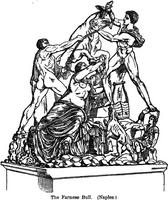
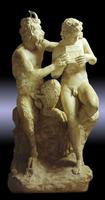
Pan and Daphnis
2nd century CE.
Marble statue of Pan teaching Daphnis to play the pipes.
Roman copy of a 2nd century BCE Greek original.
Archeological Museum, Naples.
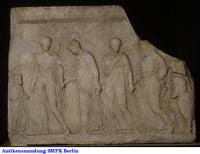 Berlin 709A
Berlin 709ACollection: Berlin, Antikenmuseen
Title: Votive Relief to the Nymphs
Subject: Three nymphs led by Hermes in a dance
Function: Votive Class: Stele, relief-decorated
Material: Marble (
Whitish-gray marble
)
Date: ca. 410 B.C. - 400 B.C. Period: High Classical
Style: High Classical
Region: Latium
Findspot: Found at Rome
Original/Copy: Original
Condition: Nearly complete
Technique: Low relief
Dimensions:
H 0.57 m, W 0.78 m, D 0.10 m, H of relief 0.02 m
Scale: Miniature
Condition Description:
Relief plaque broken in three pieces, now rejoined. Lower and part of upper edges are preserved; broken on right and upper left as well as lower left corner. Missing upper right corner including most of cave of Pan, edge of Acheloos, head of third nymph, hair of first nymph, chest and face of Hermes. Much damage to all edges. Upper band rechiseled, perhaps to erase an inscription. Surface weathered.
Sources Used:
Blümel 1966, no. 69
(Leslie Becker)
 Cast Gallery catalogue number: D086
Cast Gallery catalogue number: D086At the top are Acheloos (a river-god), Hermes, three nymphs, and Pan. Below, a hero leading a horse approaches Demeter and Persephone.
* Plaster cast: Height: 40cm.
* Copy of a marble relief.
* The relief:
o was made in the 4th century BC and dedicated to the nymphs and all the gods by a group of washerwomen.
o was found in the stadium of Athens in 1759.
o was formerly in Venice, Museum Nani.
o was purchased for Berlin by Waagen in 1841.
o is now in Berlin, Antikensammlung, inv. 709.
* C. Blümel, Die klassischen griechischen Skulpturen (Berlin, 1966) 77-78, K 90, pls. 123-124.
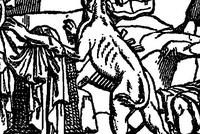
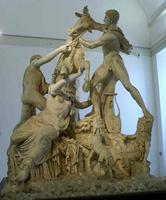
Δεν υπάρχουν σχόλια:
Δημοσίευση σχολίου